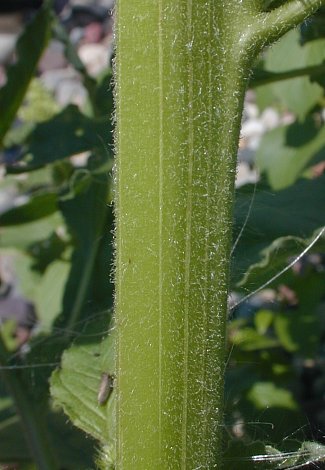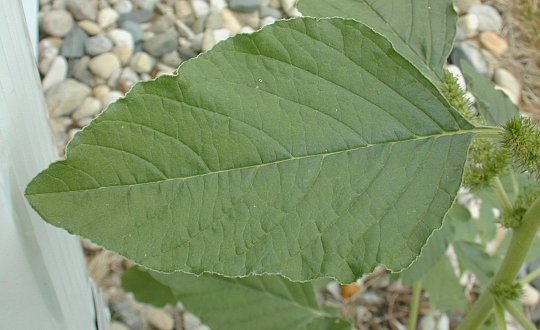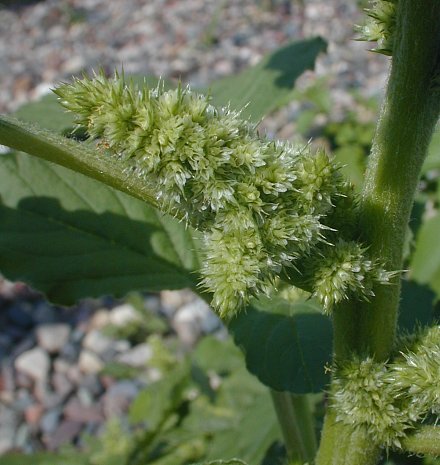Description: This plant is a summer annual about 1-3' tall that is either sparingly branched or unbranched. The central stem is stout, round, light green, and more or less covered with white hairs; it also has fine longitudinal veins that are white. The alternate leaves are up to 6" long and 4" across (excluding the petioles), becoming smaller in the upper half of the central stem. They are cordate-ovate or elliptic and smooth or slightly undulate along the margins. The base of each leaf is rounded or wedge-shaped, while its tip is rounded and blunt. The lower surface of each leaf is usually pubescent, while the upper surface is less pubescent or hairless.

The central stem terminates in a stout panicle of spikes with whitish green flowers. This terminal inflorescence is up to 6" long (rarely longer in large plants). There are also shorter axillary panicles of flowering spikes or simple spikes that develop from the axils of the middle to upper leaves. The flowering spikes are bristly in appearance from the crowded flowers and pointed bracts. Rough Pigweed is usually monoecious with separate pistillate (female) and staminate (male) flowers on the same plant. The pistillate flowers have 5 pale white sepals, an ovary with 3 styles, and no petals. The staminate flowers have 5 pale white sepals, 5 stamens, and no petals. The sepals are oblong and about 3 mm. in length; their tips are either short and pointed or flattened. At the base of each flower, there are one or more green bracts about 3-6 mm. long. These bracts have long pointed tips. The blooming period occurs from late summer to early fall and lasts about 1-2 months. Cross-pollination of the flowers is by wind. Each pistillate flower develops a single seed in a membranous bladder (utricle). This utricle splits up to release the seed. Each small seed is dark brown or black, flattened, and circular; it has a smooth and shiny surface. The root system consists of a short stout taproot that is usually tinted red. This plant spreads by reseeding itself.

Cultivation:
This
plant is typically found in full sun, mesic to dry conditions, and a
soil containing loam, clay-loam, or gravelly material. Its size can
vary significantly according to moisture levels and the fertility of
the soil. The seeds can remain viable in the soil for 30 years or more.
Range & Habitat:
The non-native Rough Pigweed is a common plant that occurs in most
counties of
Illinois (see Distribution
Map). It is originally from South America. Habitats include
degraded upland prairies, cropland,
fallow fields, farm lots, gardens, gravelly areas along roads and
railroads, sunny areas along the foundations of buildings, and waste
areas. Highly disturbed areas are preferred.

Faunal
Associations:
Insects rarely visit the wind-pollinated flowers. The caterpillars of
the skipper Pholisora catullus (Common Sootywing)
feed on this plant, as do the caterpillars of several moths, including Spilosoma virginica (Virginia Tiger Moth), Papaipema nebris (Common Stalk Borer Moth), and Coleophora lineapulvella. Other insects that feed on Rough Pigweed (Amaranthus retroflexus) include Amara aenea (Common Sun Beetle) and other seed-eating ground beetles (Amara spp., Harpalus spp.), Disonycha glabrata (Pigweed
Flea Beetle) and other flea beetles (Disonycha spp., Systena spp.),
leaf-mining larvae of Anthomyiid flies (Pegomya spp.), Geocoris bullatus (Large Big-eyed Bug), Piesma cinereum (Pigweed Bug), aphids (Aphis spp.), Spharagemon collare (Mottled Sand Grasshopper), and Gryllus pennsylvanicus (Fall Field Cricket). The latter cricket eats the seeds. The Insect Table has a more complete list of insects that feed on Amaranthus spp. (Amaranth,
Pigweed). The
seeds of amaranth and pigweeds are an important source of food for the
Greater Prairie Chicken and such granivorous songbirds as the Mourning
Dove, Chipping Sparrow, Lark Sparrow, Field Sparrow, and Horned Lark
(see Bird Table for a more complete list of these species). Pigs
and cattle feed on
pigweeds readily, although the foliage can cause bloating and other
symptoms of nitrate poisoning if an excessive amount of it is consumed
(Georgia, 1913). White-tailed Deer browse on pigweeds to a limited
extent, spreading their seeds to new locations (Myers et al., 2004).
Photographic Location:
Along the pebbly foundation of the web master's apartment building in
Urbana, Illinois.

Comments: Rough Pigweed is another weedy member of the Amaranth family, although its seeds are an important source of food to birds. It is quite similar in appearance to another common weed, Amaranthus hybridus (Slender Amaranth), and prefers similar habitats (perhaps those that are slightly drier). Rough Pigweed tends to be shorter and stouter in its growth habit than Slender Pigweed. The flowering spikes of Rough Pigweed are usually more stout and bristly than those of Slender Pigweed; the flowering spikes of Rough Pigweed are whitish green while in bloom, while the flowering spikes of Slender Pigweed are more green (because its sepals are less conspicuous). Using a 10x hand lens, it is possible to observe that the sepals of Rough Pigweed often have flattened tips, while the sepals of Slender Pigweed are more pointed at their tips. Furthermore, the floral bracts of Rough Pigweed are up to 6 mm. in length, while those of Slender Pigweed are up to 4 mm. in length. Red forms of Rough Pigweed apparently don't occur; reddish pigweeds are usually Slender Pigweed, or less often a cultivated Amaranth that has escaped from gardens.